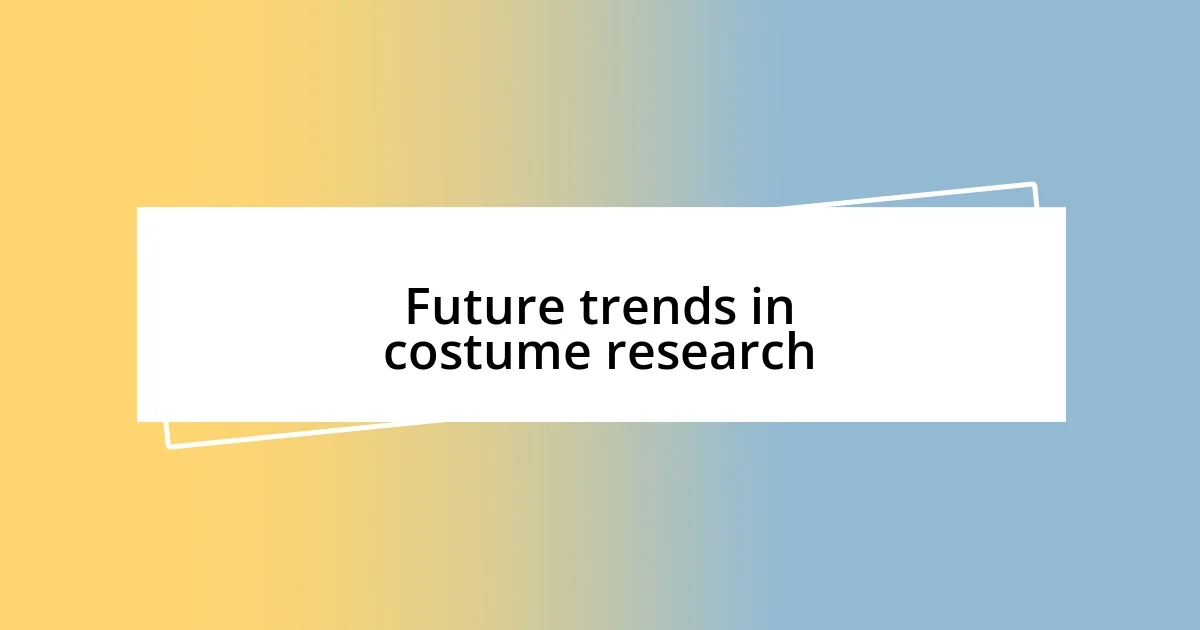Key takeaways:
- Costume history research is an emotional journey, revealing the cultural and social narratives woven into historical garments.
- Utilizing a combination of digital archives, social media, and museum visits enhances the depth and breadth of costume research, fostering community and collaboration.
- Future trends in costume research emphasize the integration of technology, inclusivity, and sustainability to enrich understanding and practice in the field.

Introduction to costume history research
Diving into the world of costume history research feels like stepping through a time portal. When I first explored this fascinating field, I was captivated by the stories that clothing could tell—about social status, cultural shifts, and even the nuances of daily life in different eras. Isn’t it incredible how a simple garment can encapsulate the essence of a time and place?
As I skimmed through old photographs and scoured through textiles, I often found myself wondering: What motivated individuals to dress the way they did? Each costume research project unfolds layers of historical context, personality, and artistic expression. I remember unearthing a Victorian dress, its intricate lace whispering tales of elegance and societal expectation, and I couldn’t help but feel a deep connection to the woman who once wore it.
Costume history research isn’t just an academic pursuit; it’s an emotional journey. The more I learned, the more I felt the pulse of history alive in the fabrics and designs. Each stitch and embellishment holds the power to evoke nostalgia, sparking curiosity and empathy for those who came before us. Isn’t it remarkable how these tangible remnants of the past can foster such profound feelings?

Tools for costume history research
While immersing myself in costume history research, I’ve discovered that having the right tools can make all the difference. Digital archives, for instance, are a treasure trove for anyone delving into the past. I remember spending hours lost in the Library of Congress digital collections, where high-resolution photos of historical fashion enabled me to analyze details I could only dream of seeing up close. This hands-on approach was like peering through a magnifying glass into history itself.
Another incredible tool is social media, particularly platforms like Pinterest and Instagram. I often find inspiration and connect with fellow enthusiasts who share my passion for vintage attire and historical garments. Just last week, I stumbled upon a shared post about Regency-era fashion that led me down a rabbit hole of research, pulling me into a community where ideas and resources flowed freely. Engaging with this vibrant online community has not only broadened my perspective but has often sparked unique collaborations that feed my ongoing projects.
When it comes to physical resources, don’t underestimate the power of museum visits. Museums offer invaluable access to original garments and exhibitions that bring history to life. I once stood in awe before a mannequin showcasing a gown from the 18th century, and it felt surreal to be inches away from something that had once graced the ballrooms of history. The tactile experience and expert insights shared by curators can significantly deepen your understanding, making history feel less like a date in a book and more like a lived experience.
| Tool | Benefits |
|---|---|
| Digital Archives | Access to high-resolution historical images and documents |
| Social Media | Networking opportunities with fellow researchers and inspiration sharing |
| Museum Visits | Tactile experiences and direct access to original garments |

Resources for historical costume analysis
When I dove deeper into the realm of historical costume analysis, my discoveries were greatly enhanced by the wealth of resources available. Academic books and scholarly journals serve as invaluable references, often peppered with detailed illustrations and photographs that illustrate fashion trends across eras. I recall poring over a comprehensive volume on Elizabethan attire; the meticulous descriptions helped me understand not only the garments but their significance in the social fabric of the time.
Here’s a quick rundown of resources you might find helpful in your own research journey:
- Academic Books: Offer in-depth analysis and context about specific time periods, styles, and cultural significance.
- Journals and Articles: Provide the latest research and theories within the field of costume studies, often exploring niche topics.
- Costume Collections Online: Websites like The Costume Institute provide digital access to extensive collections, showcasing garments with expert commentary.
- Documentaries and Films: Visual storytelling that brings historical costumes to life, allowing viewers to appreciate the intricacies of design and fabric.
In my own explorations, I’ve found that attending workshops hosted by costume historians can spark unexpected connections. I remember sitting in a cramped workshop in a historic theatre, where participants were encouraged to construct a period garment using authentic techniques. The smell of fabric and the sound of scissors cutting cloth brought a wave of energy that almost felt like a collective heartbeat of creativity. There’s something magical about learning in such an immersive setting; it truly deepens my appreciation for the craftsmanship behind each piece. Connecting with like-minded individuals during these experiences has enriched not just my knowledge, but also my passion for historical costumes.

Methodologies for studying costume history
Exploring methodologies for studying costume history has led me to realize the importance of interdisciplinary approaches. By weaving together art history, sociology, and material culture, I’ve been able to form a richer narrative about how garments reflect the values and practices of their time. For example, during my research on 19th-century workwear, I found myself delving into social history texts that illuminated the lives of those who wore these clothes. It’s fascinating how a simple garment can unlock stories about identity and class dynamics, don’t you think?
One methodology I found particularly compelling is comparative analysis. It’s like placing two time periods side-by-side and watching the evolution of fashion unfold. While working on a project comparing Victorian and Edwardian styles, I vividly remember being surprised by the fluctuating attitudes towards femininity. The shift from the heavily corseted silhouettes of the Victorians to the slightly more liberated looks of the Edwardians was a revelation. I often wonder how such transformations in fashion correlate with the societal changes of their respective eras. This kind of inquiry doesn’t just provide clarity; it reveals the intricate tapestry of our collective history.
Lastly, collaborating with craftspeople can add another layer to my understanding of costume history. I had the chance to partner with a local tailor who specializes in period clothing. As I watched her craftsmanship in action, I began to appreciate the techniques and materials used to create authentic garments. It’s one thing to read about the process, but witnessing the skills firsthand infused my research with a depth that books alone couldn’t provide. Have you ever experienced something similar that made you see your research in a whole new light?

Case studies in costume history
Exploring various case studies in costume history has truly illuminated the nuances of fashion throughout the ages for me. One notable example is the examination of the iconic flapper dresses from the 1920s. I remember sifting through archival photographs, captivated by the bold colors and geometric patterns that embodied a newfound freedom. It struck me how these garments were not merely clothing but symbols of a cultural shift—women asserting their independence and embracing modernity. Isn’t it fascinating how clothing can encapsulate such monumental societal changes?
Another compelling case study that caught my attention is the evolution of the corset. Initially designed to shape and support, these garments have undergone significant transformations. I once attended a lecture on Victorian corsetry, where the speaker vividly illustrated how these pieces reflected the era’s beauty standards and even health beliefs. As I watched the audience react to the stark images of constricted waists, I felt a wave of empathy wash over me. It prompted me to question: how often do we overlook the emotional and physical toll that fashion can impose? This kind of inquiry emphasizes the importance of contextualizing garments within their cultural frameworks.
I’ve also dived into the world of historical reenactments, which can serve as a living case study. Participating in a Civil War reenactment, I donned a wool dress that weighed heavily on my shoulders, instantly transporting me into the past. The experience was both enlightening and exhausting, revealing the practical challenges faced by those in history. It made me ponder: how do modern conveniences skew our understanding of historical experiences? Each case study provides a unique lens through which to view the complexities of costume history, enriching my research endeavors and personal reflections along the way.

Challenges in costume history research
Researching costume history can often feel like navigating a maze of fragmented information. One challenge I faced was finding reliable sources, as many garments remain shrouded in mystery, with limited documentation. I remember combing through dusty archives, feeling both excitement and frustration as I pieced together clues about a dress’s origin—doesn’t it make you wonder how much we still don’t know?
Another significant hurdle is interpreting the social context around various styles. I recall a particularly eye-opening moment when I studied the context of 18th-century court fashion. The extravagant displays of wealth were not just about aesthetics; they reflected power dynamics and societal hierarchies. This left me pondering: how often do we miss the messages woven into the very fabric of our clothes?
Lastly, recreating historical garments can be a daunting task, especially when considering their unique construction methods. While attempting to replicate a Victorian skirt, I found myself grappling with the complexities of draping and layering. It was incredibly humbling to realize that there’s so much artistry involved in these pieces. Have you ever tried your hand at crafting something with historical significance? The experience truly deepened my appreciation for the skill and labor behind each garment.

Future trends in costume research
The future of costume research is becoming increasingly intertwined with technology. I recently experimented with virtual reality (VR) applications that allow users to experience historical settings fully immersed in them. It was like stepping into a time machine; I wandered through a 19th-century ballroom, completely surrounded by the attire and ambiance of the era. This made me wonder: could VR transform the way we teach and understand fashion history?
Another trend I’m noticing is the rise of collaborative platforms where researchers from diverse backgrounds come together to share knowledge and resources. During a recent forum, I engaged with a scholar who specialized in Indigenous costume history. Our discussions opened my eyes to perspectives I had never considered, emphasizing the importance of inclusivity in costume research. It made me reflect: how much richer could our understanding become if we embraced such diversity?
Additionally, sustainable practices are gaining traction in costuming. I remember visiting a modern costume studio where the designer showcased her methods of repurposing vintage fabrics. Seeing how garments can be transformed while preserving their historical integrity felt like a revelation. I found myself asking, how can we honor fashion history while also pushing for a more sustainable future in costume design? Such questions are crucial as they guide us toward a more responsible and thoughtful approach to our field.














